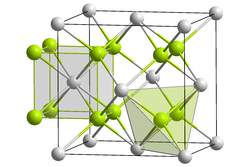 | |
 | |
 | |
 | |
| Names | |
|---|---|
| IUPAC name Lithium oxide | |
| Other names Lithia Kickerite Dilithium Monoxide Dilithium Oxide | |
| Identifiers | |
3D model (JSmol) | |
| ChemSpider | |
| ECHA InfoCard | 100.031.823 |
PubChem CID | |
| RTECS number |
|
| UNII | |
CompTox Dashboard (EPA) | |
| |
| |
| Properties | |
| Li 2O | |
| Molar mass | 29.88 g/mol |
| Appearance | white or pale yellow solid |
| Density | 2.013 g/cm3 |
| Melting point | 1,438 °C (2,620 °F; 1,711 K) |
| Boiling point | 2,600 °C (4,710 °F; 2,870 K) |
| Reacts to form LiOH | |
| log P | 9.23 |
Refractive index (nD) | 1.644 [1] |
| Structure | |
| Antifluorite (cubic), cF12 | |
| Fm3m, No. 225 | |
| Tetrahedral (Li+); cubic (O2−) | |
| Thermochemistry | |
Heat capacity (C) | 1.8105 J/g K or 54.1 J/mol K |
Std molar entropy (S⦵298) | 37.89 J/mol K |
Std enthalpy of formation (ΔfH⦵298) | −20.01 kJ/g or −595.8 kJ/mol |
Gibbs free energy (ΔfG⦵) | −562.1 kJ/mol |
| Hazards | |
| Occupational safety and health (OHS/OSH): | |
Main hazards | Corrosive, reacts violently with water |
| NFPA 704 (fire diamond) | |
| Flash point | Non-flammable |
| Related compounds | |
Other anions | Lithium sulfide Lithium selenide Lithium telluride Lithium polonide |
Other cations | Sodium oxide Potassium oxide Rubidium oxide Caesium oxide |
| Lithium peroxide Lithium superoxide | |
Related compounds | Lithium hydroxide |
Except where otherwise noted, data are given for materials in their standard state (at 25 °C [77 °F], 100 kPa). | |
Lithium oxide (Li
2 O), or lithia, is an inorganic chemical compound. It is a white or pale yellow solid. Although not specifically important, many materials are assessed on the basis of their Li2O content. For example, the Li2O content of the principal lithium mineral spodumene (LiAlSi2O6) is 8.03%. [2]

